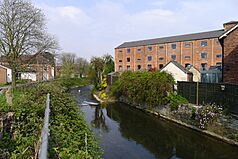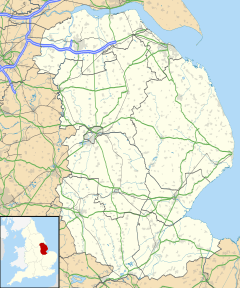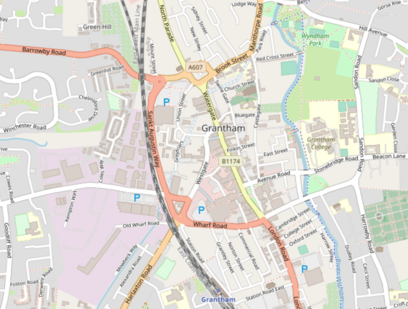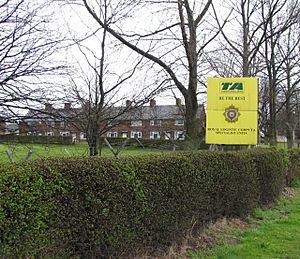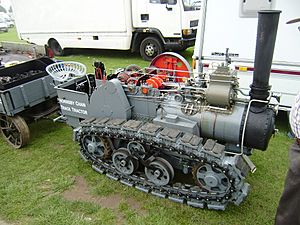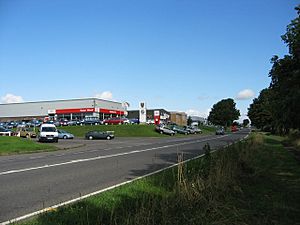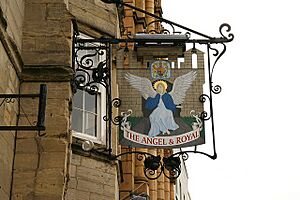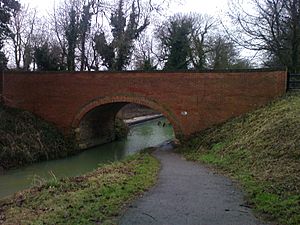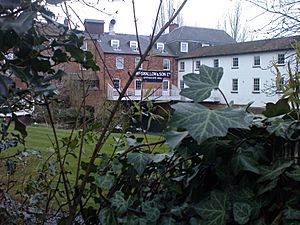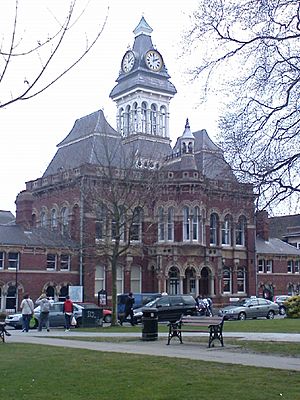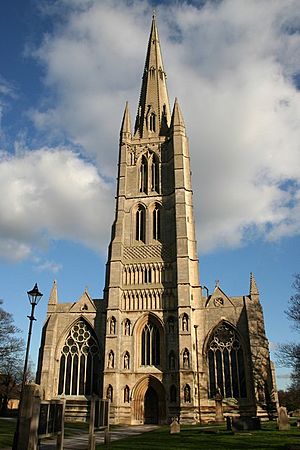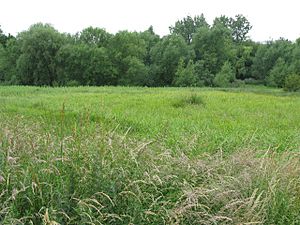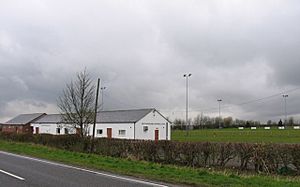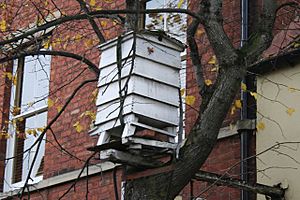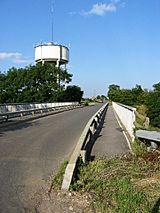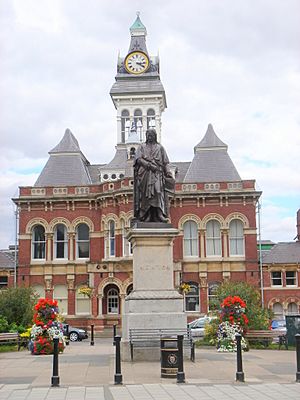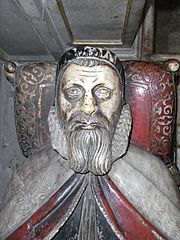Grantham facts for kids
Quick facts for kids Grantham |
|
|---|---|
|
Top to bottom, left to right: Market Place, Grantham Guildhall and statue of Sir Isaac Newton, Vine Street, skyline of Grantham, St Wulfram's Church and Bridge End Road with the River Witham passing through |
|
| Population | 44,580 (ONS, 2016) |
| OS grid reference | SK9136 |
| • London | 100 mi (160 km) S |
| Civil parish |
|
| District |
|
| Shire county | |
| Region | |
| Country | England |
| Sovereign state | United Kingdom |
| Post town | GRANTHAM |
| Postcode district | NG31 |
| Dialling code | 01476 |
| Police | Lincolnshire |
| Fire | Lincolnshire |
| Ambulance | East Midlands |
| EU Parliament | East Midlands |
| UK Parliament |
|
| Website | Visit Grantham, South Kesteven District Council |
Grantham (/ˈɡrænθəm/) is a historic market town and civil parish in Lincolnshire, England. It sits by the River Witham and is near the A1 road. The town is about 23 miles (37 km) south of Lincoln and 22 miles (35 km) east of Nottingham. In 2016, about 44,580 people lived there. Grantham is the biggest town and main administrative centre of the South Kesteven District.
Grantham is famous for being the birthplace of Margaret Thatcher, who became the UK's first female Prime Minister. The brilliant scientist Isaac Newton also went to school here at the King's School. The town was also where the UK's first official female police officer, Edith Smith, started work in 1914. Plus, the first working diesel engine in the UK was made here in 1892, and the first tractor in 1896.
Contents
- What's in a Name? The Story of Grantham
- Grantham's Landscape and Surroundings
- Grantham's Ancient Past
- Grantham in Medieval Times
- Grantham's Modern Story
- Grantham's Economy Today
- Who Lives in Grantham?
- Getting Around Grantham: Transport Links
- Learning in Grantham: Education
- How Grantham is Governed
- Places of Worship
- Fun Things to Do in Grantham
- Sports in Grantham
- Grantham's Twin Town
- Famous Places and Buildings
- Famous People from Grantham
- See also
What's in a Name? The Story of Grantham
The name Grantham first appeared in the Domesday Book in 1086. Its exact meaning isn't fully known. The ending -hām comes from Old English and means "homestead" (a home and its land).
The first part of the name might be from a person's name, Granta. Or it could come from an Old English word, Grand, meaning "gravel". So, Grantham could mean "Granta's homestead" or "homestead by gravel". Over time, how people say the name has changed to its modern sound.
Grantham's Landscape and Surroundings
Grantham is located in the South Kesteven area of Lincolnshire, in the East Midlands of England. The town is surrounded by other smaller villages and areas. Most of the town's buildings are within its own parish boundaries.
Hills, Rivers, and Soil
The town lies in the valley of the River Witham. The Witham flows from south to north through Grantham. Another stream, the Mowbeck, joins the Witham in the town centre.
The ground in the valley is mostly made of mudstone and sand. The soil near the river is often wet and sandy. As you go higher up on the east and south sides of town, the ground rises sharply. This area is known as the Lincoln Cliff. The soil here is usually good for farming. To the west, the town is close to the Vale of Belvoir, with hills that rise over 100 meters.
The Grantham Canal, which opened in 1797, follows the Mowbeck stream. It connects Grantham to places like Nottingham.
How Grantham is Built Up
The oldest part of Grantham is around Westgate, Brook Street, and Castlegate. This is where you'll find the main shops and businesses, along with many old buildings.
North of the town centre, you'll see houses built in the 1700s, 1800s, and 1900s. Further north, there are larger, newer housing areas built in the 1970s and 1980s.
South of the town centre, there are many brick houses from the late Victorian and Edwardian times. These were first built for factory workers. This area is called Spittlegate. Further south-east, there are more modern housing estates.
The north-east part of Grantham has many 20th-century homes. This includes parts of the Harrowby Estate, which started as council housing in 1928. There are also parks like Wyndham Park in this area.
The western edge of town has different types of developments from the 20th century. These include the Earlesfield estate, industrial areas, and a leisure centre.
Grantham's Weather
The British Isles have a mild, maritime climate with warm summers and cool winters. Data from a nearby weather station shows that Grantham's average daily temperature is about 9.8°C (49.6°F). It's warmest in July, averaging 16.9°C (62.4°F), and coolest in January, averaging 3.9°C (39.0°F).
| Climate data for Cranwell, elevation: 62 m (203 ft), 1991–2020 normals | |||||||||||||
|---|---|---|---|---|---|---|---|---|---|---|---|---|---|
| Month | Jan | Feb | Mar | Apr | May | Jun | Jul | Aug | Sep | Oct | Nov | Dec | Year |
| Mean daily maximum °C (°F) | 7.0 (44.6) |
7.8 (46.0) |
10.4 (50.7) |
13.4 (56.1) |
16.5 (61.7) |
19.4 (66.9) |
22.1 (71.8) |
21.8 (71.2) |
18.6 (65.5) |
14.3 (57.7) |
9.9 (49.8) |
7.7 (45.9) |
14.1 (57.3) |
| Mean daily minimum °C (°F) | 1.3 (34.3) |
1.3 (34.3) |
2.6 (36.7) |
4.5 (40.1) |
7.2 (45.0) |
10.2 (50.4) |
12.2 (54.0) |
12.2 (54.0) |
10.1 (50.2) |
7.2 (45.0) |
3.9 (39.0) |
1.6 (34.9) |
6.2 (43.2) |
| Average precipitation mm (inches) | 48.1 (1.89) |
38.4 (1.51) |
36.3 (1.43) |
44.6 (1.76) |
48.4 (1.91) |
59.8 (2.35) |
53.5 (2.11) |
59.5 (2.34) |
50.5 (1.99) |
62.4 (2.46) |
56.6 (2.23) |
54.6 (2.15) |
612.7 (24.13) |
| Average precipitation days (≥ 1.0 mm) | 10.9 | 9.5 | 9.3 | 9.0 | 8.6 | 9.4 | 9.1 | 9.6 | 8.7 | 10.3 | 11.3 | 11.0 | 116.7 |
| Mean monthly sunshine hours | 65.1 | 83.7 | 124.2 | 163.0 | 209.2 | 191.6 | 202.2 | 187.6 | 151.1 | 113.6 | 74.4 | 65.6 | 1,631.3 |
| Source: Met Office | |||||||||||||
Grantham's Ancient Past
It's hard to learn about Grantham's very early history because much of it is buried under the modern town. But we know that ancient hunter-gatherers visited the area.
Stone Age Discoveries
Some of the oldest tools found are Palaeolithic axes, dating back 40,000 to 150,000 years ago. Later, Mesolithic flints (4,000 to 8,000 years old) were found near the river. Neolithic people probably settled here because of the rivers and good soil. There's also evidence of a Neolithic ritual site near Harlaxton.
Bronze Age and Iron Age Life
Bronze Age items like pottery and burial sites have been found. However, there isn't much direct proof of Bronze Age settlements in the town itself. We know even less about the Iron Age, though some old ditches and field systems have been found.
Roman Times in the Area
Many Roman coins and pottery have been found in Grantham. Small Roman settlements or farms were likely here. A very important Roman site was found 3 km (1.9 miles) south of Grantham at Saltersford. This was a crossing point on the River Witham for an old trade route called Salter's Way. It might have been a small town with a market.
Grantham in Medieval Times
Historians believe Grantham started as an important Anglo-Saxon settlement, possibly by the 600s. Its name suggests it's very old.
Early Beginnings
Some historians think Grantham became an important estate centre before the Viking invasions in the 800s. Others believe the town and its surrounding area (called a soke) were set up around the 1040s or 1050s by Queen Edith and Earl Leofric. They might have also started St Wulfram's Church around this time.
By the time of the Domesday Book in 1086, Grantham was a town and a royal manor (land owned by the king). It was a valuable place, and the king often gave it to his loyal supporters.
Royal Ownership and a Special Charter
The manor of Grantham was given to different powerful families by the king over many centuries. It often returned to the Crown (the king's ownership) when families died out or lost favour.
In 1463, King Edward IV rewarded Grantham for its loyalty during the Wars of the Roses. He gave the town a special charter. This meant Grantham could govern itself with its own council, led by an Alderman. This was a big step for the town's independence.
Grantham's Modern Story
The 1800s and 1900s
The town grew a lot when the railway arrived. The first train line came in 1850, followed by the main London line in 1852. Gas lighting was introduced in 1833, making the town brighter at night. In 1835, the town's local government became a borough council.
Many housing estates west of the town centre were built in the 1970s. Before that, they were just green fields.
Grantham's Military Past
Grantham has a long history with the military. The Old Barracks were completed in 1858.
Dambusters and Air Force Headquarters
During the famous Dambuster Raids in May 1943, the Royal Air Force's Bomber Command had its headquarters in a building called St Vincents in Grantham. This building is now a private house. Later, during World War II, it was also the headquarters for the USAAF's IX Troop Carrier Command.
RAF Spitalgate
RAF Spitalgate was an airfield that trained pilots during both World Wars. It was the first military airfield in Lincolnshire. It closed in 1974. After it closed, it became the Prince William of Gloucester Barracks for the Royal Logistic Corps.
The RAF Regiment was also formed near Grantham in 1941, at RAF Belton Park. This is considered its birthplace.
The First Policewoman
Grantham was one of the first towns in the UK to hire and train women police officers. In December 1914, Miss Damer Dawson came to Grantham to help set up the women police. In 1915, Edith Smith was sworn in by magistrates, making her the first policewoman in Britain with full powers to arrest people.
Grantham's Industrial Story
Richard Hornsby & Sons
Richard Hornsby and Richard Seaman started their company, Seaman & Hornsby, in Grantham in 1810. They made things like ploughs and seed drills. Later, the company became Richard Hornsby & Sons.
From 1840, they built steam engines. After 1906, they focused on oil, petrol, and gas engines. In 1905, they invented a caterpillar track for their machines.
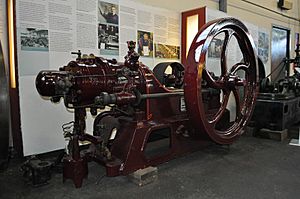
In 1892, Hornsby's built a prototype high-pressure engine. This engine ran for six hours and is considered the first known diesel engine. In 1910, Hornsby showed its caterpillar track vehicle to the British Army. They later sold the patent for their track to an American company, Holt Manufacturing, which eventually became the famous Caterpillar Inc. Tractor Company.
In 1918, Hornsby's joined with another company to become Ruston & Hornsby. During World War II, the Grantham factory made tanks, like the Matilda. The factory closed in 1963.
Aveling-Barford
Another important company, Aveling-Barford, moved into a former Hornsby's site in 1934. They made agricultural engines and steamrollers. In the 1970s, Barford's was the biggest employer in Grantham, with about 2,000 workers. They even developed the world's smallest tractor, the Barford Atom, in 1947.
Today, the company is called Invictas Engineering and makes dumper trucks for construction sites.
BMARC
British Manufacture and Research Company (BMARC) in Springfield Road made weapons. They famously made the Hispano cannon for the Spitfire and Hurricane fighter planes from 1937. The company closed in 1992, and the site is now a housing estate.
Grantham's Economy Today
The food industry and Grantham Hospital are currently the biggest employers in the town. Companies like Moy Park (poultry production) and Aviagen Turkeys have hatcheries here.
At Easton, a few miles south of Grantham, there are large facilities for frozen food storage and distribution (Norbert Dentressangle) and potato processing (McCain Foods).
Grantham Book Services (GBS), a book distribution company, has been based in Grantham since 1975.
Hotels and Places to Stay
There are several hotels and places for events in the Grantham area. These include the Olde Barn Hotel, Belton Woods Hotel, and Stoke Rochford Hall.
The Angel and Royal Hotel
The Angel and Royal on the High Street is thought to be the oldest inn in England. The current building is about 600 years old, but there was an inn on the site for 200 years before that. It even started as a hostel for the Knights Templar. Many kings have visited, including King John and Richard III. The name "Royal" was added after visits from King Charles I, George IV, and Edward VII.
Recent Closures
Some businesses in Grantham have closed in recent years. The Marks and Spencer branch closed in 2010 due to low sales, though a Food Hall later reopened. The discount department store Boyes took over the old Marks and Spencer building.
Who Lives in Grantham?
People and Beliefs
According to the 2011 census, most of Grantham's population (96.3%) is white. About 2.0% are Asian, and other groups make up smaller percentages. Most people (90.1%) were born in the United Kingdom.
In terms of religion, 69.4% of Grantham's population said they were religious in 2011. Most of these were Christians (67.6%). Other religions like Hinduism, Islam, and Buddhism are present in smaller numbers.
| Ethnicity, nationality and religious affiliation of residents (2011) | |||||||||||||
|---|---|---|---|---|---|---|---|---|---|---|---|---|---|
| White | Asian or British Asian | Black, African, Caribbean or Black British | Mixed or multi-ethnic | Other ethnicity | Born in UK | Born in EU (except UK and Ireland) | Born outside EU | Religious | Did not follow a religion | Christian | Muslim | Other religions | |
| Grantham | 96.3% | 2.0% | 0.6% | 0.9% | 0.2% | 90.1% | 6.1% | 3.4% | 69.4% | 23.8% | 67.6% | 0.5% | 0.9% |
| England | 85.4% | 7.8% | 3.5% | 2.3% | 1.0% | 86.2% | 3.7% | 9.4% | 68.1% | 24.7% | 59.4% | 5.0% | 2.5% |
Jobs and Skills
In 2011, about 72.7% of Grantham's working-age residents were employed. A higher percentage of people work full-time here compared to the rest of England. The most common jobs are in wholesale and retail, manufacturing, and health and social work.
Grantham has fewer people in professional or administrative jobs compared to the national average. About 23.7% of residents aged 16-74 have no formal qualifications. However, 19.8% have a university-level qualification or higher.
| Economic characteristics of residents aged 16 to 74 (2011) | ||
|---|---|---|
| Characteristic | Grantham | England |
| Economic activity | ||
| Economically active | 72.7% | 69.9% |
| Employed | 69.9% | 62.1% |
| Full-time employed | 42.7% | 38.6% |
| Retirees | 13.9% | 13.7% |
| Long-term sick or disabled | 3.9% | 4.0% |
| Long-term unemployed | 1.6% | 1.7% |
| Industry | ||
| Agriculture | 0.9% | 0.8% |
| Manufacturing | 13.9% | 8.8% |
| Construction | 7.3% | 7.7% |
| Wholesale and retail trade; repair of vehicles | 19.1% | 15.9% |
| Transport and storage | 5.0% | 5.0% |
| Accommodation and food services | 6.0% | 5.6% |
| Information and communication | 2.0% | 4.1% |
| Financial and insurance | 2.4% | 4.4% |
| Professional, scientific and technical | 3.9% | 6.7% |
| Public administration and defence | 6.7% | 5.9% |
| Education | 7.7% | 9.9% |
| Health and social work | 12.9% | 12.4% |
| Occupation | ||
| Managers and directors | 9.3% | 10.9% |
| Professionals; associate professionals | 21.8% | 30.3% |
| Administrative and secretarial | 10.8% | 11.5% |
| Sales and customer services | 9.4% | 8.4% |
| Caring, leisure and other services | 10.5% | 9.3% |
| Skilled trades | 12.8% | 11.4% |
| Process, plant and machine operatives | 10.9% | 7.2% |
| Elementary occupations | 14.4% | 11.1% |
| Qualifications | ||
| No qualifications | 23.7% | 22.5% |
| Level 4 or higher | 19.8% | 27.4% |
Areas of Wealth and Need
Grantham has both wealthy areas and areas with more challenges. Some parts of the Earlesfield estate are among the most deprived (meaning they have more difficulties like low income or poor health) areas in the country. However, other areas like Green Hill and Spinney housing estates are among the least deprived.
Getting Around Grantham: Transport Links
Train Travel
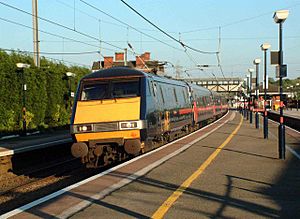
Grantham railway station is on the main London to Edinburgh East Coast Main Line. It's also a stop for trains between Nottingham and Skegness (the Poacher Line). Electric trains started running here in 1988. Grantham is the best-served train station in Lincolnshire.
In 1906, a train accident in Grantham killed 14 people. On July 3, 1938, the famous steam locomotive Mallard set the world speed record for steam trains (126 mph or 203 km/h) just south of Grantham.
Road Connections
The Great North Road, a very old main road, was routed through Grantham in 1196. The modern A1 bypasses the town, meaning it goes around it, which was built in 1962. The A52 also goes through Grantham.
A new road project, the Grantham Southern Relief Road, has been planned since 2007 to help with traffic. Parts of it have opened, and the full road is expected to be completed by 2023, though some delays have occurred.
Waterways for Fun and History
Grantham was once connected to Nottingham by the Grantham Canal. You can now walk and cycle along parts of the canal.
The River Witham flows through Grantham and has a lovely riverside walk. You can see swans, ducks, and trout along the river.
Learning in Grantham: Education
Grantham College is a further education college for students who have finished secondary school. It opened in 1948.
Grantham has two well-known grammar schools: Kesteven and Grantham Girls' School and The King's Grammar School. Both have large sixth forms (for older students). Margaret Thatcher attended the Girls' School, and Isaac Newton went to The King's School. Both schools have remained single-sex up to age 16.
The Priory Ruskin Academy is a co-educational school near Manthorpe. It is part of a larger group of schools. Grantham also has independent primary schools like Grantham Preparatory School.
How Grantham is Governed
Grantham used to be a municipal borough. In 1974, it became part of the South Kesteven district.
From 1974 until April 2024, Grantham was an "unparished area," meaning it didn't have a local parish council. Instead, a group called the Charter Trustees looked after the town's traditions and ceremonies. On April 1, 2024, Grantham officially became a parish again, and a new Grantham Town Council took over these duties.
The town is part of the Grantham and Bourne constituency. Its Member of Parliament (MP) is Gareth Davies from the Conservative Party.
Places of Worship
Grantham has many different churches. The most famous landmark is St Wulfram's Church. It has one of the tallest spires among English churches, standing over 282 feet (86 meters) high. Inside, it has England's first public library, which started in 1598.
Other churches include the Catholic Church of St Mary the Immaculate, Grantham Baptist Church, and Finkin Street Methodist Church, which Margaret Thatcher attended.
Fun Things to Do in Grantham
Parks and Leisure
Wyndham Park and Dysart Park both have play areas for children. Wyndham Park also has a paddling pool and a cafe. The Meres Leisure Centre has an indoor swimming pool.
The public library is located in the Sir Isaac Newton Centre. You can also visit Grantham Museum and the Guildhall Arts Centre, which has a theatre.
Belton House, a beautiful National Trust property, is nearby. It has events for children, a play area, and woodland walks.
Nature and Wildlife
Grantham is home to peregrine falcons, which sometimes nest in St Wulfram's Church. The town is surrounded by countryside and woods like Ponton Park Wood and the Woodland Trust's Londonthorpe and Alma Park Woods. These woods offer great views and walks.
South of town, the River Witham flows through marshes and meadows. Here you can see many plants and wildlife, including grey herons, mallards, water voles, and different types of dragonflies.
Grantham Gingerbread
The town is famous for its gingerbread biscuits. They were first made in 1740 by a baker named William Eggleston. He accidentally created a ginger-like biscuit while trying to bake another type of biscuit. This mistake was a big success, and Grantham Gingerbread became well-known. It's a "white" gingerbread, meaning it doesn't use dark treacle, giving it a delicate ginger flavour and a hollow, honeycomb-like centre.
Local News and Radio
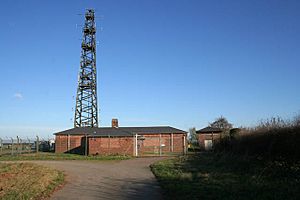
Grantham's local newspaper is the Grantham Journal, which started in 1854. Local news and TV are provided by BBC East Midlands and ITV Central. Grantham also has its own community radio station, Gravity FM, run by local volunteers.
Sports in Grantham
Football Teams
Grantham Town Football Club is the local football team. They play at the South Kesteven Sports Stadium, which also has an athletics track. Another local team is Harrowby United F.C.
Patrick Bamford, a professional footballer for Leeds United, was born in Grantham.
Rugby and Hockey
Kesteven Rugby Football Club was founded in 1947 and has men's, women's, and junior teams. Grantham Hockey Club also has teams that play at the Meres Leisure Centre.
Other Sports
Grantham has successful bowls players who compete in county and national competitions. The town also hosted international table tennis matches in the 1990s.
Grantham's Twin Town
Grantham is twinned with Sankt Augustin in Germany. They have been twin towns since 1980. The A52 relief road in Grantham is named Sankt Augustin Way, and Sankt Augustin has a "Grantham-Allee".
Famous Places and Buildings
Grantham House is a National Trust property near the church.
Grantham has a unique "living" public house sign: a beehive with real bees outside the Beehive Inn since 1830.
The Grantham Guildhall on St Peter's Hill is now the Guildhall Arts Centre. A road next to it, Edith Smith Way, is named after England's first policewoman.
The Blue Pig pub on Vine Street is one of only a few Tudor buildings left in the town. It survived the big fires of the 1660s. The George Hotel was even mentioned in Charles Dickens's novel Nicholas Nickleby.
The Grantham and District Hospital is located in the north of the town.
Nearby, there are many historic houses like 17th-century Belton House, 19th-century Harlaxton Manor, and Stoke Rochford Hall.
On May 15, 2022, a 10-foot 6-inch (3.2 meters) bronze statue of Margaret Thatcher was put up on St Peter's Hill Green. It was placed on a tall base to help protect it from damage.
Famous People from Grantham

Many notable people have connections to Grantham:
Police and Military
- Philip Knights, Baron Knights (1920–2014), a police officer.
- Walter Richard Parker (1881–1936), a Royal Marine who won the Victoria Cross.
- Edith Smith (1876–1924), the first woman police officer with full arrest powers in Britain.
Arts and Entertainment
- Judy Campbell (1916–2004), an actor and playwright.
- Eric Chappell (born 1933), a comedy writer.
- Colley Cibber (1671–1757), an actor and poet, who attended The King's School.
- Holly Humberstone (born 1999), a singer and songwriter.
- Nicholas Parsons (1923–2020), a famous television and radio presenter.
- Richard Todd (1919–2009), an actor.
Religion
- Frederic Barker (1808–1882), an Anglican Bishop of Sydney.
- John Still (1593–1608), a Bishop of Bath and Wells.
Science and Engineering
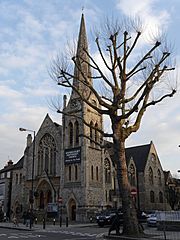
- Charles Bell (1846–1899), an architect.
- Isaac Newton (1642–1726/27), the famous physicist and mathematician.
Sports Stars
- Patrick Bamford (born 1993), a professional footballer for Leeds United.
- Ian Bowyer (born 1951), a professional footballer.
- Charles P. Dixon (1873–1939), an Olympic gold, silver, and bronze medal-winning tennis player.
- Timothy Grubb (1954–2010), an Olympic show jumper.
- Vikki Hubbard (born 1989), an international high jumper.
- Simon Terry (1974–2021), an Olympic Bronze medal-winning archer.
- Luke Wright (born 1985), a first-class cricketer.
See also
 In Spanish: Grantham para niños
In Spanish: Grantham para niños







